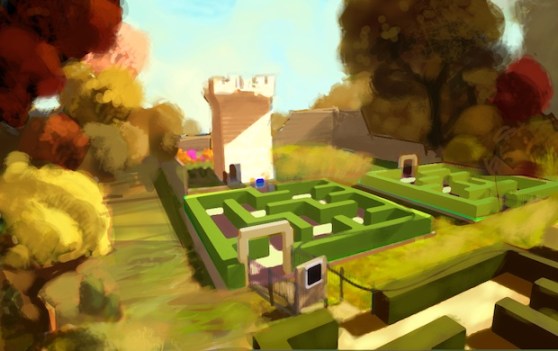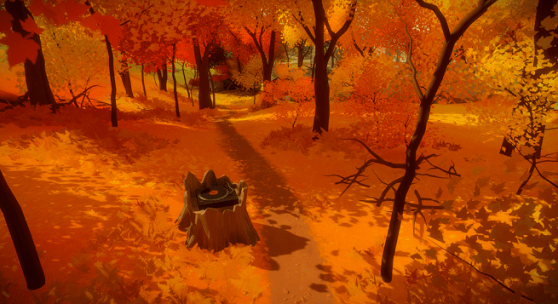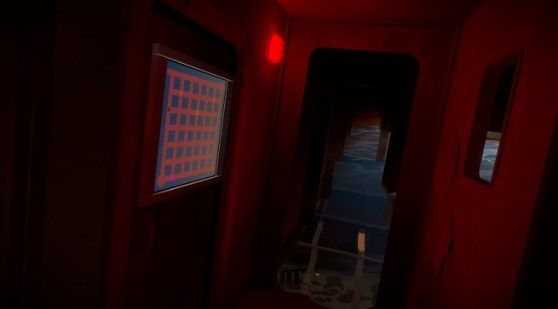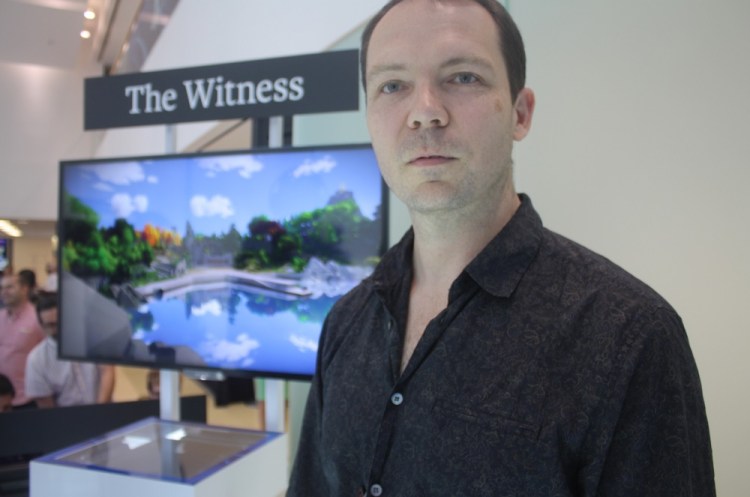When Jonathan Blow demos his new game, The Witness, he lets the player drive — alone. In the puzzle adventure, you start out in a room with a door. You open it by completing a very simple task, drawing a line with your mouse or controller from one point to another. The door opens and it leads to a single passage, which then leads to a garden. You solve increasingly complex puzzles to open more doors. And then you’re free to roam around an island.
It seems simple enough, but Blow has been working on The Witness since 2009. As an independent developer, it takes time to finish his titles. But he scored big time with his first major release, Braid, which debuted in 2008. He earned a 90 out of 100 rating on review-aggregator Metacritic for Braid, and the sales from the game financed The Witness. With luck, Blow said that he’ll be able to finish his latest experience by the holidays. But he won’t ship it until it’s done. He is targeting it first for the PlayStation 4, and then it will come out on the PC and iOS after that.
176 game developers on what makes them the most money:
the VB Mobile Games Monetization report.
Blow’s title is an important test to show whether an indie dev who has had one success can move on to another and still stay true to his roots. He recently showed off The Witness at a preview event at Sony’s U.S. game headquarters in San Mateo, Calif. We caught up with him there and interviewed him. Here’s an edited transcript of our conversation.
June 5th: The AI Audit in NYC
Join us next week in NYC to engage with top executive leaders, delving into strategies for auditing AI models to ensure fairness, optimal performance, and ethical compliance across diverse organizations. Secure your attendance for this exclusive invite-only event.

Above: A screenshot from The Witness.
GamesBeat: Can you tell me what you’re trying to do with The Witness?
Jonathan Blow: It’s a big and complex game, so I’ll hit a few points. What you played is most of the tutorial area. There’s this panel and this force field. Once you get that down, you can go out and wander the whole island. Before you go out, there’s an area that acclimates you to operating these funky LCD panels that are kind of like iPads mounted around the environment. What the rest of the game does is it uses that as a basic element to build general puzzle solving and exploration. This game hearkens back to games like Myst and whatnot.
GamesBeat: Yeah, I had Myst in my head while I was playing.
Blow: Yeah. It’s pensive. It’s up to you to notice things and solve things. In the beginning, the things to solve are relatively simple. This one on the screen now is about as hard as it gets. There’s two ways you could go, and one of them doesn’t work. It’s about acclimating you to the interface. Then, you get out into the rest of the world and more sophisticated puzzles get built around this interface.
That does a couple of things. One, it gets rid of all the ambiguity and confusion that characterizes adventure games. You play a Myst-style game, you walk in a room, and there’s a weird machine there. You might point and click at different things on the machine to figure out what to operate, and most of it doesn’t work. Is this even turned on? What am I doing? You drag out all of your inventory items. Do I activate this with that? That’s the gameplay of most adventure games, and it sucks. It’s not fun.
GamesBeat: You get the urge to cheat, right? And just look up the solution.
Blow: Yeah. What I’m doing here is streamlining that process. You have these things in the environment that tell you, quite explicitly, “This is a puzzle. It’s right here. The way that you solve it is by drawing a line.” You just don’t know which line to draw. In the beginning it’s pretty straightforward, but as you go further into the game, you start needing to pay attention to more environmental cues. You need to solve subtler, more lateral-thinking problems to figure out what to input. The line becomes almost like a secret code, where you have to know the right shape for it.
That gives us a framework where we can get rid of the bad parts of adventure games and give you more of a flow in gameplay. Adventure is a really old genre, going back to when nobody knew what they were doing with video games. We’ve figured out a lot of things. Different genres have this idea of what the moment of gameplay is. In a racing game, I’m staying on the track and trying to go fast, but not go too fast, or I’ll lose control. In a fighting game, I’m timing button sequences, so I can get through the guy’s guard.
In an adventure game, the flow is supposed to be this problem solving. I see a problem, I think about how to solve it, and I do the solution. But in a classic adventure game, the flow is blocked because you spend all your time being confused. This is about removing the confusion and only leaving the good part, that circle of seeing a problem and solving a problem. We get to more of a flow. That’s one of many aspects of this game. It’s not the only one.

Above: A forest setting in The Witness.
GamesBeat: How do you go about creating a game like this? Do you come up with the puzzles first?
Blow: The game’s been in development a long time — five years. Development has changed its nature a lot. Early in development, it was about very abstract — just putting puzzles in an engine that looks really bad, not worrying about graphics, mapping out the island, and making sure these locations aren’t that far from each other. You want people to be able to find puzzles without wandering for hours. Later on, it’s more about modeling and making places look nice. Tuning the puzzles so that they’re as good as they can be. Tuning the engine so it runs at a good framerate on all the platforms. We’re in more of that latter polishing and tuning time now.
GamesBeat: The game’s name makes it seem like it’s a story-driven experience. Is that correct?
Blow: Let me put it this way. You could play through the entire game without taking part in a story at all. The story happens in audio logs that you find around the world, in sort of a BioShock style. You could ignore them if you want. If you choose not to ignore them, they may help answer the question of, what’s the mythology in this place? Why are these puzzles here? What’s their purpose? What are you doing here? It’s a process of answering those questions.
GamesBeat: You’re basically starting with zero knowledge in this game.
Blow: Exactly. There’s no opening cutscene that you missed. You’re in a dark hallway with a thing at the end. The way you started is exactly the way the game ships. The story part actually comes into play after you leave this area.
GamesBeat: Did you have some admiration for Myst or something that led you to make a game like this?
Blow: I liked Myst when it came out. The mood and the style are really nice. It’s primitive pre-rendered stuff that doesn’t hold up today, but at the time it was interesting. I wanted to do a modern version of that, using that aesthetic of “lonely and beautiful” that you get in that kind of game.
Going back and playing those games, the game design isn’t very good by modern standards in any adventure game. I wanted to do a good game design that takes what we’ve learned in the past 20 years and applies it to the genre.

Above: Another scene from The Witness.
GamesBeat: You had a big success before this with Braid. Did you have any advantages this time around to really do what you wanted to do?
Blow: We had a much higher budget. But the game is also a lot bigger. Braid was a four- or five-hour single-player game. This is maybe 25 or 30 hours. That’s six or seven times as big, and in 3D, which is always hard. But it’s been great because when we started building this 3D game, I said we’re a small indie team. There’s no way it’s going to look good. It’s going to look kind of amateur, and that’s fine. We’ll just make the gameplay good. But to my surprise, we have managed to make a really beautiful game. Our trailer was in the PS4 launch announcement last year, which is unheard-of exposure for an indie developer. I’m really happy with that. The development cycle’s been long, though. It’s been a lot of work.
GamesBeat: One of the Gone Home guys was talking about this new class of “super indies” now, teams that are able to make these kinds of games.
Blow: We’re able to do it with this game, but then this game has to be successful.
GamesBeat: Or you’re back to regular indie?
Blow: That’s always a possibility. We’ll see.
GamesBeat: Have you been pleased with your decision to go with Sony?
Blow: Yeah, I’m very happy. The console’s nice. Of all the consoles we could have chosen to be our main target, it’s the nicest one to develop for. It also seems to have the largest active user base right now. That’s growing. So hey, I couldn’t have necessarily predicted that, but it’s great.
GamesBeat: What are you taking advantage of in the PS4 that you might not have otherwise been able to?
Blow: In our game, it’s mostly that it’s a fast computer with fast graphics and a lot of memory. The memory makes it easier to develop for. There’s a lot of stuff about the platform that I think is neat but that we’re not the right game for. The sharing stuff and live streaming is super cool, but this is a single-player puzzle game. That spoils all the puzzles. So we’re not going to emphasize that feature. I’m happy we picked the platform, though. We’re doing great on it.

Above: The Witness is coming to the PlayStation 4 first.
GamesBeat: Are you close to finishing the game?
Blow: This year is the plan. That’s a little scary because we may end up launching during the big Christmas game launches. We’ll see.
GamesBeat: The whole indie ecosystem seems to be in pretty good shape now.
Blow: 2008 was a good year. Braid came out that year and a few other indies. Around 2009, I was thinking this can’t last that long. What happens in markets is people show up, the gold rush happens, and it fills up. That’s happened to some extent. Some indies are complaining now, “I can’t get on Steam. Nobody pays attention to my game.” And that’s true, compared to 2008. But it’s still really wide open. If you work hard on your game and it has something eye-catching about it, some good story behind it, you have a very good chance of getting it in front of people now.
When I started in games, in 1996, it was impossible. You had to get something through retail. So, I’m very happy. Steam is a more open place, in a sense, than even something like Sony, where you have to sign a deal with a relatively closed group. There are still plenty of games getting through there.
GamesBeat: Are you into a period of polishing the game now?
Blow: That’s the hardest part. All the ideas have already happened. All the creative part, or most of the creative part, has happened. Now, it’s just nailing it down. I’m enjoying how most of the big risks are behind us. We’re not going to run out of money before we finish. We’re not going to have an ugly game. We’re not going to have some gameplay element that seemed promising but ends up sucking. All those risks are down. We just need to finish it. That’s nice. But I also run the business, design the game, and program. It’s a lot to do.
GamesBeat: It seems like the idea has sustained you a long time. You haven’t gotten bored.
Blow: No, it had to be a good idea to last me five years.

Above: The Witness might come in time for the holidays.
[youtube=http://www.youtube.com/watch?v=i7h7AleSCF4&w=560&h=315]


